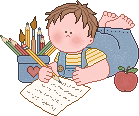
|
 |

|
 |
| Dictation helps teach the child-author that
a written story is an oral one put into print.
Dictation also helps demystify the orthographic features of print such as: the movement of words from left to right, top to bottom, the spaces between words, and the punctuation marks. Dictation stories provides young storytellers with many opportunities to learn sub-skills of reading, such as: the formation of letters, progression of words.
|

|

|
|
Dictation allows each child the opportunity to tell his/her story to the
teacher. Stories
can be original or borrowed. The teacher should feel free to ask whatever questions are necessary to help the child express himself/herself. The teacher role in taking dictation is a complicated one. She must strive to understand what the child intends to say in his/her story and write it down. Dictation should also occur on a regular basis (at least twice o three times a week). Dictation is about developing a relationship to stories, it's about what's inside. In telling their stories, children develop a relationship to their own stories as well as a relationship to print.
|

|

|
|
Stage 1: Pre-Writing Control of Language: For the very young, storytelling is associated with talking. First stories may not contain any sentences. Newcomers to storytelling who are a little older might offer a whole sentence or more, but the stories are often not representative of the child's linguistic sophistication in normal circumstances. Awareness of writing: Storytelling in the first stage of dictation are often unaware of the relationship between what they are saying and what the teacher is writing down. The finished product is, unintentional. Later on, during the dramatization process, novice storytellers often seem surprised that the teacher has a piece of paper with the same words on it that they had told her earlier. These children are in the earliest stages of relating to print. Physical Behavior: The physical behavior of novice storytellers is also significant. They rarely position themselves for the role. Sometimes they can't resist the urge to write as the teacher writes, and they insist on their own paper and pencil.
|

|
|
Stage 2: Almost Writing Control of Language: Young storytellers have begun to control the language the scribe writes down. Storytellers will now frequently speak in sentences, though the sentences might not form a coherent whole. They are satisfied with simple references to themselves, family life, and events that are based in reality. Awareness of writing: The storyteller has made a leap in his/her understanding of writing as separate from drawing. Some children dictate very quickly, unaware that writing is slower than talking. Before children can be expected to write their own stories, they should have plenty of opportunities to observe the rhythm of writing down speech. Writing what one thinks is a learned, not a natural skill. Physical Behavior: The child comes to the storytelling table ready to act like a storyteller, waiting for the moment to begin.
|

|
|
Stage 3: Ready to Write Control of Language: The children exhibit a fuller sense of story: they come to the storytelling table with ideas to fashion into a story; they are aware of the written page as representation of their ideas. Awareness of writing: The storyteller's ideas are usually clear and logical. They have adopted the formal language of storytelling: they are comfortable with convections such as "Once upon a time...". Now the storytelling takes possesion of the print out a mistake or interesting idea. Physical Behavior: The young storytellers have settled down in their chairs. They tell stories efficiently and effortlessly. The content of their stories may still be oriented toward superheroes.
When Stories Come To School: Telling, Writing, and Performing Stories in the Early Childhood Classroom by Patsy Cooper
|
 |
:
: